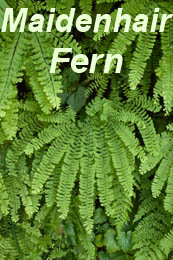Herb Garden
The joy of growing and using herbs
Foxglove and Ferns
by Rachel McLeod
 The foxglove (Digitalis spp) is a truly medicinal herb and not one that you would ever administer to yourself. But how lovely it looks in the garden or in the herb garden! The foxglove (Digitalis spp) is a truly medicinal herb and not one that you would ever administer to yourself. But how lovely it looks in the garden or in the herb garden!
People who grew up with foxgloves will know that there is something magical about the plant. Even its name is imaginative. Erroneously, it is frequently explained that it is derived from Folk's glove, that the bell like flower served as gloves for the little folk or fairies. This always troubled me as a child, all the fairies I knew, real or imagined were far too small to use the foxglove flowers as mittens. However the German name for foxglove is Fingerhut or thimble and in 1542 this suggested to the botanist Leonhard Fuchs that the genus foxglove should be classified under the botanical name Digitalis (from digitus, the Latin for finger).
The medicinal qualities of the foxglove leaves were discovered in England by a Dr. William Withering in 1775 when he observed that a local herbal tea was successful in curing dropsy. He found that the active ingredient was foxglove leaves; later doctors discovered that the foxglove's action was primarily on the heart. As well as being a diuretic, it also strengthens and regulates the heartbeat. Digitalis is still one of the most important heart medicines and has not been synthesized but is made from the leaves of foxgloves specially grown to regulate the amount of digitalis in the plant. Digitalis lantana is the species used for the commercial use and is grown in south eastern Europe. It is a zone 7 plant and probably not reliably hardy in Canada.
However, other species are hardy and foxgloves make a beautiful addition to our gardens. The tall, pink spires are elegant in the flower border or naturalized on the edge of the woodland. The ones we know best are variations on the common purple foxglove (Digitalis K). All will grow in sun or part shade, and need very good drainage, a light soil and cool root run. If they are really happy with their conditions they will self seed freely and sometimes even make extra rosettes at the base and act as a perennial for a year or two. There are apricot strains and a white without the usual interior spots. They are excellent and long lasting as cut flowers.
Two other species are successful in my garden. One is Digitalis lutea, the yellow foxglove. This is an unassuming plant, which makes a nice clump and produces small, clear yellow flowers all through the summer.
The second is one of my favorite plants. It is the Rusty Foxglove (Digitalis ferruginea). It is so happy here that not only does it act as a perennial but it self seeds abundantly, always seeming to choose just the right place; fortunately the seedlings are easy to pull if necessary. It has a handsome rosette of shiny leaves which persists through the winter and in the second year grows a tall spike of closely set, small, golden brown flowers. If the plants are grouped together they are very effective, particularly set against the dark green background of the cedars where they look like tall, very slim candles.
In the garden foxgloves are particularly beautiful when planted with ferns. Rather surprisingly, not many ferns have herbal qualities but the ones that historically have been used are very beautiful and will enhance a shady garden.
In particular the Male fern (Dryopteris felixmas) was used as a vermifuge to expel tapeworms. It is the brown, scaly root rhizome which is used as the medicine. From this rhizome, beautifully curled shoots appear in spring. These lengthen out and grow into large fronds and a well developed plant could be more than a metre in diameter.
The Maidenhair fern (Adiantum pedatum) is one of the most fragile looking plants in the garden. Its delicate divided leaves quiver in the slightest breeze on the ends of wiry, black stems. The leaves were made into a tea with honey and used as a hair tonic and to combat asthma and chest ailments such as coughs or asthma. Although it looks delicate, it is surprisingly tough and my plants grow in very dry conditions. Good drainage and shade are essential.
For somewhat damper conditions where there is plenty of space, the Ostrich Fern (Matteuchia pensylvanica) will grow well. Although it does not have a medicinal reputation it provides the delicious fiddleheads for us to eat in the early spring. It is easily recognized in the winter by its dark brown fertile fronds standing upright in groups through the snow and providing winter interest in the garden. Mark these and you will have a gourmet dish in the spring.
Rachel McLeod founded Kiln Farm Herb Garden in Puslinch, Ontario in 1974.
|

